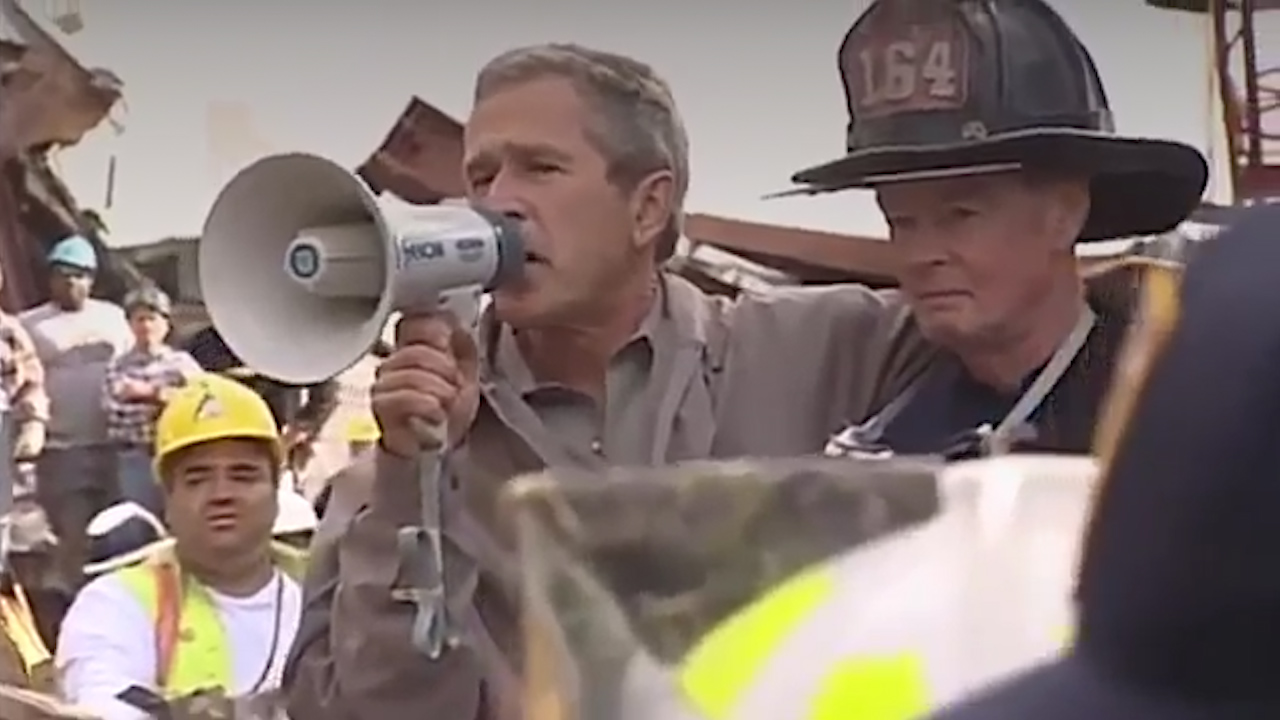A number of decades ago, I attended an Arlo Guthrie concert. A presidential primary campaign cycle was heating up — probably 1980, but I’m not sure. Guthrie, in his wise-fool persona, claimed to be anxious about the state of the nation because “All these people on TV, they’re telling me we need leadership and we’re just not getting it.” Then he described how on some recent evening, just before going to bed, he had brushed his teeth and then looked in the mirror and asked himself: “Arlo, did you need leadership today?”
That line was funny — and continues to be funny years later — because it captures the disconnect between political rhetoric and our actual lives. Guthrie’s joke is on us, and how easily manipulated we are. In the heat of a campaign, it’s easy to become either excited or enraged over some “issue” that (when you boil it down) really has no effect on either yourself or anyone you know or care about, and may be little more than a phrase or an image.
And so, during his campaign launch Wednesday, Ron DeSantis talked about the “the woke mind virus”, “woke ideology”, and “critical race theory”. The Republican he hopes to catch up to, Donald Trump, spends most of his speeches talking about his persecution by the Deep State. He offers to replace President Biden’s “weakness” with his own “strength”. Kevin McCarthy and Republicans in Congress have been focused on America’s “spending problem”, an issue whose lack of substance I examined a few weeks ago.
Any of those “issues” might take the place of Guthrie’s “leadership”. I can imagine myself staring into my own bathroom mirror and asking, “Doug, did you need protection from the woke mind virus today?”
Meanwhile, President Biden has been spending his time trying to avoid crashing into the debt ceiling, a looming disaster that is real enough, but is also entirely manufactured. Rather than solve our problems, politicians have created a new one to wrestle with.
Isn’t it wonderful that the external world isn’t presenting any challenges that require our collective action?
Well, except for climate change. Biden seems to know about that problem, but it was all he could do this week to avoid rolling back the anti-climate-change parts of the Inflation Reduction Act. Despite governing a state that will soon start vanishing under rising oceans, DeSantis seemed oblivious, saying “I’ve always rejected the politicization of the weather.” Trump still occasionally refers to climate change as a hoax.
Biden and other Democrats occasionally talk about gun violence, domestic terrorism, and the threats to American democracy. But there is little pending legislation of any consequence on any of those issues, other than efforts at the state level to roll back gun restrictions, increase gerrymandering, and take control of its elections away from one of our largest cities.
And then there are the problems that neither party is talking about. In the coming months I plan to call attention to a few, starting with: declining life expectancy in the United States. It would be bad enough if our political system were simply oblivious to the problem. But in fact political action is causing a lot of it.
Talk about a matter of life and death.
Declining life expectancy. In the United States, like most of the world, life expectancy had gone up and up for centuries, until the last few years. Here’s a graph of US life expectancy from 1860 to 2020.

Except for brief glitches during the Civil War and the World War I/Spanish flu era, life expectancy at birth goes inexorably upward, almost exactly doubling from 39.41 in 1860 to 78.94 in 2015. Not even World War II could bring it down (probably because the health advantages of ending the Depression overcame the casualties of war). Until recently, Americans had come to think of increasing lifespans as an inevitable dividend of scientific progress. Of course our generation would live longer than our parents’ generation, and our children would live longer yet.
Different sources produce slightly different numbers, but just about everybody sees a leveling-off in the mid-2010s, followed by a sharp drop in the last few years to levels not seen since 1996. Nearly three decades of progress have vanished.

Now, there’s an obvious reason for this: the Covid pandemic, which has killed 1.1 million Americans since it started in 2020 (and is not done, even if we’ve stopped paying attention to it). Largely because of mismanagement by the Trump administration and misinformation from the larger MAGA movement (which encouraged lax attitudes, snake-oil cures, and vaccine resistance), we took a bigger hit than most comparable countries. The US has had 3,480 Covid deaths per million people, while Canada has had 1,364, Norway 986, and Australia 801. Even some of the countries hit earlier and harder than the US have fared better in the long run: Italy has had 3,159 deaths per million and Spain 2,595. One likely reason: 86% of Spaniards and 81% of Italians have been vaccinated, compared to 69% of Americans.
But OK then: If Covid is the problem, it should go away as Covid recedes. And that’s happening in the rest of the world. But not here.

The headline from this graph is that life expectancy in comparable countries bounced back in 2021, almost regaining its 2019 level, while life expectancy in the US dropped further. But there’s also a long-term story here: In 1980, US life expectancy was lower than the comparable-country average by less than a year. By 2021, though, the gap had grown to more than six years. Even pre-Covid, there was a 3.8 year gap.
Where did that come from?
Bad habits or bad government? The simple explanations for our long-term life expectancy gap focus on our bad habits: We’re too fat, we’re out of shape, we take drugs, and we kill ourselves and each other at a high rate. It’s easy to tell the life-expectancy story as a crisis of individual moral gumption: If Americans would just eat better, get off the couch, get clean from drug abuse, and deal with our depression and anger problems, we’d live longer.
And all that is true as far as it goes. But if you look at those “moral” problems, each one has a political component.
Guns. Most obviously, our high suicide and murder rates are related to our gun policies. People get depressed and angry in other countries too. But depressed or angry Americans are more likely to have ready access to guns. In 2020, researchers at Stanford published a study on the relationship between guns and suicides:
The researchers found that people who owned handguns had rates of suicide that were nearly four times higher than people living in the same neighborhood who did not own handguns. The elevated risk was driven by higher rates of suicide by firearm. Handgun owners did not have higher rates of suicide by other methods or higher rates of death generally.
The researchers themselves wrote:
Suicide attempts are often impulsive acts, driven by transient life crises. Most attempts are not fatal, and most people who attempt suicide do not go on to die in a future suicide. Whether a suicide attempt is fatal depends heavily on the lethality of the method used — and firearms are extremely lethal. These facts focus attention on firearm access as a risk factor for suicide especially in the United States, which has a higher prevalence of civilian-owned firearms than any other country and one of the highest rates of suicide by firearm.
In general, gun deaths are higher in states with more guns.
:format(webp):no_upscale()/cdn.vox-cdn.com/uploads/chorus_asset/file/10259683/mother_jones_gun_deaths_by_state.png)
Food policy. Obesity is a major factor in Americans’ poor health, and is the one most likely to be seen as a moral issue. (“Just stop stuffing your face, fatso.”) But while we can all imagine ways that we could improve our discipline regarding diet and exercise, it’s also true that it’s hard to live a healthy lifestyle in the United States.
Nationally, our food policy tilts towards putting high-fructose corn syrup in just about everything. Our giant factory farms make meat and dairy cheaper here than in many other countries, but also less healthy. Particularly in our poorer neighborhoods, fast food is easier to find than fresh vegetables. The food industry spends billions every year trying to persuade us to eat fat- and sugar-laden foods.
Compared to cities in other countries, American cities encourage travel by car and discourage walking.
In short, there are reasons we’re fat. And not all of them are lack of willpower.
The place this really becomes clear is when you look at children. Even if you think obese adults lack willpower, do you really hold children responsible for their food-and-exercise choices?
Healthcare. Some politicians like to claim that American healthcare is “the best in the world”. And that may be true if you’re rich or have excellent health insurance, live near a top medical center, and need the kind of major medical interventions American medicine specializes in.
But overall, our public health is terrible compared to other rich countries, all of whom spend less per capita on healthcare than we do. For example,
Among 11 developed countries, the United States has the highest maternal mortality rate, a relative undersupply of maternity care providers, and is the only country not to guarantee access to provider home visits or paid parental leave in the postpartum period, a recent report from The Commonwealth Fund concluded. Compared with any other wealthy nation, the United States also spends the highest percentage of its gross domestic product on health care.
Maternal deaths have been increasing in the United States since 2000, and although 700 pregnancy-related deaths occur each year, two-thirds of these deaths are considered to be preventable.
The statistical term for preventable deaths is “amenable mortality”. In 2019 — pre-Covid, in other words — amenable mortality in the US was responsible for 177 deaths for every 100K people, compared to a 38-country average of 126. Japan and Switzerland had 83, and Canada 116.
The difference is our reliance on the private sector. In the US health-insurance business, the way to make money is to insure only healthy people. Much of the administrative effort in our health-insurance companies is devoted to shifting costs onto someone else, rather than improving health overall.
And of course, the private health-insurance industry has no interest in the poor at all. If poor and lower-working-class Americans aren’t on Medicaid, they’re probably uninsured. Uninsured people fear our expensive healthcare system, and are likely to hope problems go away on their own rather than get them checked out. Those decisions end up killing a lot of people.
One conservative policy designed to limit healthcare spending is to give people more “skin in the game“. In other words, to increase copayments so that people (especially the poor) have more incentive to ignore problems and hope they go away on their own.
Red states and blue states. The policies I’ve been talking about — limiting gun access, subsidizing healthy food choices (or penalizing unhealthy ones), promoting public health, lowering medical copayments, pushing for walkable cities, and making it easier to get health insurance — are classic liberal policies that conservatives ridicule as examples of the “nanny state”. Blue states are more likely to take these actions than red states.
And guess what? Blue states have higher life expectancy than red states. Paul Krugman tweeted the following chart comparing Biden’s margin over Trump in 2020 to each state’s change in life expectancy over the previous 30 years:

He comments:
Life expectancy is hugely unequal across U.S. regions, with major coastal cities not looking much worse than Europe but the South and the eastern heartland doing far worse.
But wasn’t it always thus? No. Geographic health disparities have surged in recent decades. According to the U.S. mortality database, as recently as 1990, Ohio had slightly higher life expectancy than New York. Since then, New York’s life expectancy has risen rapidly, nearly converging with that of other rich countries, while Ohio’s has hardly risen at all and is now four years less than New York’s.
Summing up. Life expectancy ought to be a major political issue. Americans aren’t living as long as citizens of other rich countries, but that isn’t due to some unforeseeable act of God. We’re doing it to ourselves through our political choices.







 Long after it had become clear that the reopenings were premature and cases were spiking, Trump pushed to hold dangerous large-crowd events in Tulsa and Phoenix. (Fortunately for the nation, the crowd in Tulsa was
Long after it had become clear that the reopenings were premature and cases were spiking, Trump pushed to hold dangerous large-crowd events in Tulsa and Phoenix. (Fortunately for the nation, the crowd in Tulsa was 








